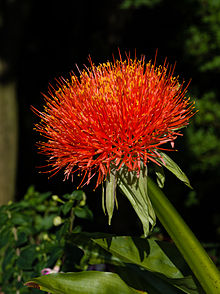Scadoxus multiflorus
| Scadoxus multiflorus | ||||||||||||
|---|---|---|---|---|---|---|---|---|---|---|---|---|

Scadoxus multiflorus |
||||||||||||
| Systematics | ||||||||||||
|
||||||||||||
| Scientific name | ||||||||||||
| Scadoxus multiflorus | ||||||||||||
| ( Martyn ) Raf. |
Scadoxus multiflorus is a plant type from the family of the Amaryllis (Amaryllidaceae). The approximately nine species of this genus were previously in the genus haemanthus ( Haemanthus provided). Also Scadoxus multiflorus often appears under the name " blood flower ", but also sometimes referred to as "Fireball Lily" in the trade .
description
Vegetative characteristics
In Scadoxus multiflorus is a perennial herbaceous plant . This geophyte forms onions as persistent organs. The simple, wavy leaves are about 40 centimeters long. The leaf bases form a pseudo-stem that is often mottled purple.
Generative characteristics
In spring (with Scadoxus multiflorus subsp. Katharinae in late summer) the 60 to 90, occasionally up to 110 centimeter high, umbel-shaped inflorescences appear . The hermaphrodite flowers are threefold and rose-red to scarlet. The stamens are conspicuous and long.
Occurrence
Scadoxus multiflorus is originally from Africa and colonizes numerous habitats there , which are mainly in the tropics, but extend from the South African provinces of the Eastern Cape via KwaZulu-Natal and the four northern provinces of South Africa to Swaziland , Mozambique , Zimbabwe , Namibia and Botswana , and include all areas of tropical Africa with the exception of the driest zones. In the northeast, the area stretches as far as Kenya and the southwestern Arabian Peninsula, gen West in the Sudan and Guinea Zone to Senegal .
The occurrence ranges from the lowlands to the mountain forests. Also, secondary forests , forest edges, forest savannas and open grasslands are populated. They are typically found in the shade of trees near river banks.
Systematics
The first publication took place in 1795 under the name ( Basionym ) Haemanthus multiflorus by Thomas Martyn in Monogr. cum ic. The new combination to Scadoxus multiflorus (Martyn) Raf. was published in Flora Telluriana , 4, p. 19 by Constantine Samuel Rafinesque-Schmaltz in 1838 .
From Scadoxus multiflorus there depending on the author about three subspecies:
- Scadoxus multiflorus (Martyn) Raf. subsp. multiflorus (syn .: Haemanthus colchicifolius Salisb. , Haemanthus cruentatus Schumach. & Thonn. , Haemanthus abyssinicus Herb. , Haemanthus delagoensis Herb. , Haemanthus tenuiflorus Herb. nom. superfl., Haemanthus tenuiflorus var. delagoensis) ( nom. Herb. delagoensis ) illeg., Haemanthus tenuiflorus var. mocambicensis Herb. , Haemanthus tenuiflorus var. coccineus Hook. f. , Haemanthus arabicus M.Roem. , Haemanthus rupestris Baker , Haemanthus filiflorus Baker ex Hiern , Haemanthus kalbreyeri Baker , Haemanthus bivalvis Beck , Haemanthus micrantherus Pax , Haemanthus eurysiphon Harms , Haemanthus somaliensis Baker , Haemanthus nicholsonii Baker , Haemanthus zambesiacus Baker , Haemanthus arnoldianus De Wild. & T.Durand , Haemanthus cecilae Baker , Haemanthus andrei De Wild. , Haemanthus mildbraedii Perkins , Haemanthus seretii De Wild. , Haemanthus bequaertii De Wild . , Haemanthus lynesii Stapf , Haemanthus otaviensis Dinter , Haemanthus sacculus E.Phillips ): It comes from southern and tropi from Africa to the Arabian Peninsula.
- Scadoxus multiflorus subsp. katharinae (Baker) Friis & Nordal (Syn .: Haemanthus katharinae Baker , Haemanthus multiflorus subsp. katharinae (Baker) I.Bjørnstad & Friis ): It occurs in southern Africa. The number of chromosomes is 2n = 18.
- Scadoxus multiflorus subsp. longitubus (CHWright) Friis & Nordal (Syn .: Haemanthus longitubus C.H.Wright , Haemanthus multiflorus subsp. longitubus (CHWright) I.Bjørnstad & Friis , Haemanthus mannii Baker ): It occurs in the forests of tropical West Africa. The number of chromosomes is 2n = 18 or 20.
Ingredients and toxicity
The onions are poisonous due to their content of lycorin and other alkaloids .
Individual evidence
- ↑ a b c d e f Rafaël Govaerts (Ed.): Scadoxus - data sheet at World Checklist of Selected Plant Families of the Board of Trustees of the Royal Botanic Gardens, Kew. Last accessed on September 21, 2016.
- ^ Scadoxus multiflorus at Tropicos.org. Missouri Botanical Garden, St. Louis, accessed September 25, 2016.
- ↑ Scadoxus katherinae at Tropicos.org. In: IPCN Chromosome Reports . Missouri Botanical Garden, St. Louis
- ↑ Scadoxus multiflorus subsp. longitubus at Tropicos.org. In: IPCN Chromosome Reports . Missouri Botanical Garden, St. Louis
Web links
- Information from the South African National Biodiversity Institute
- Toxicity information. (engl.)
- University of California images
- Scadoxus multiflorus . In: S. Dressler, M. Schmidt, G. Zizka (Eds.): African plants - A Photo Guide. Senckenberg, Frankfurt / Main 2014.



